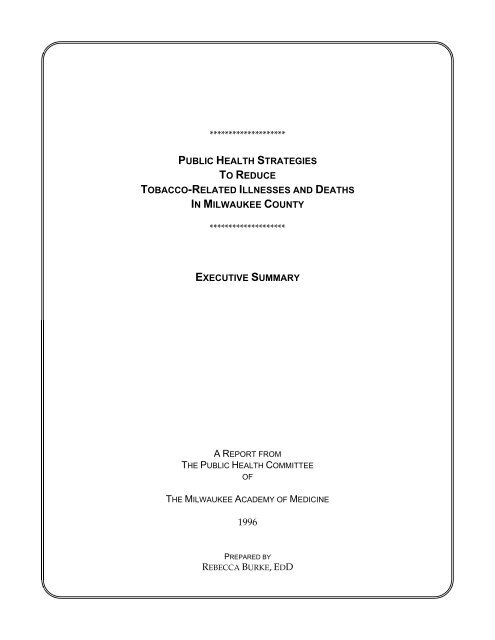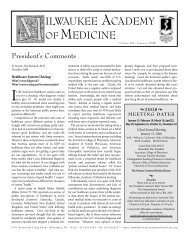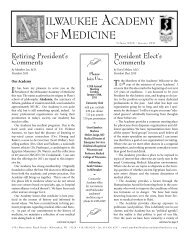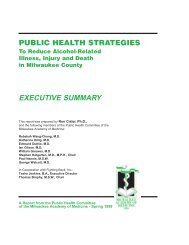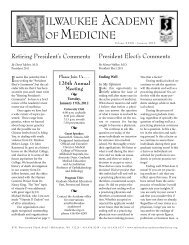Public Health Strategies To Reduce Tobacco-Related Illnesses and ...
Public Health Strategies To Reduce Tobacco-Related Illnesses and ...
Public Health Strategies To Reduce Tobacco-Related Illnesses and ...
You also want an ePaper? Increase the reach of your titles
YUMPU automatically turns print PDFs into web optimized ePapers that Google loves.
********************<br />
PUBLIC HEALTH STRATEGIES<br />
TO REDUCE<br />
TOBACCO-RELATED ILLNESSES AND DEATHS<br />
IN MILWAUKEE COUNTY<br />
********************<br />
EXECUTIVE SUMMARY<br />
A REPORT FROM<br />
THE PUBLIC HEALTH COMMITTEE<br />
OF<br />
THE MILWAUKEE ACADEMY OF MEDICINE<br />
1996<br />
PREPARED BY<br />
REBECCA BURKE, EDD
1<br />
********************<br />
PUBLIC HEALTH STRATEGIES<br />
TO REDUCE<br />
TOBACCO-RELATED ILLNESSES AND DEATHS<br />
IN MILWAUKEE COUNTY<br />
********************<br />
We must remember; there is no safe use of tobacco.<br />
It's the only legal product I know that kills when used as intended.<br />
(Antonia Novello, US Surgeon General, 1992) 1<br />
INTRODUCTION<br />
<strong>To</strong>bacco is the major known cause of addiction, preventable disease, disability, <strong>and</strong><br />
death in our society. It can damage human life at every stage of development, from<br />
embryo to old age. In spite of this knowledge, however, it is estimated that smoking<br />
contributes to 3,000,000 deaths globally; 440,000 in the United States; 8,700 in Wisconsin,<br />
<strong>and</strong> 1,530 in Milwaukee County each year. 2-4 <strong>To</strong>bacco is the largest single cause of death<br />
in the developed world.<br />
The overall purposes of this document, prepared by the <strong>Public</strong> <strong>Health</strong> Committee of the<br />
Milwaukee Academy of Medicine, are:<br />
1. to examine the current scope of the problem both nationally <strong>and</strong> in Milwaukee<br />
County, using a public health model, <strong>and</strong><br />
2. to conceptualize strategies based on this model for reducing tobacco-related<br />
morbidity <strong>and</strong> mortality in Milwaukee County.<br />
Specifically, the Milwaukee Academy of Medicine seeks to reduce both the incidence of<br />
morbidity <strong>and</strong> mortality <strong>and</strong> the economic costs attributed to tobacco use by 20% by the<br />
year 2000. Key to accomplishing these objectives is finding effective strategies for<br />
preventing the initiation of tobacco use among adolescents <strong>and</strong> children, assisting<br />
current smokers in their attempts to quit smoking, <strong>and</strong> effecting change in the political,<br />
economic, <strong>and</strong> regulatory climate that currently exist with regard to tobacco control.<br />
MILWAUKEE ACADEMY OF MEDICINE WINTER, 1996
2<br />
SCOPE & MAGNITUDE OF TOBACCO AS A HEALTH HAZARD<br />
The issue has touched all of us in personal ways. We all know friends or family members whose<br />
lives were shortened because of their involvement with tobacco. 5<br />
William J. Clinton, U.S. President, August, 1995<br />
<strong>To</strong>bacco causes approximately 8,700 premature deaths a year, or 24 deaths a day in<br />
Wisconsin. Included are about 780 non-smokers who die each year as a result of<br />
environmental tobacco smoke, perinatal conditions attributed to maternal smoking, or<br />
house fires for which cigarettes are the most common heat source. <strong>To</strong>bacco use is the<br />
leading drug addiction among Wisconsin youth (age
3<br />
MILWAUKEE COUNTY RATES<br />
<br />
<br />
1991-93: adult smokers numbered 194,125 persons, or 27% of the population<br />
over 18 years, who smoked an average of 566 packs per year.<br />
1991-93: youth smokers (11-17 years) numbered 20,880, or 23%, who averaged<br />
131 packs each per year. 4<br />
TOBACCO-RELATED COSTS<br />
Costs attributed to smoking can be calculated in a number of ways: human, economic,<br />
or health care costs, business costs due to lost productivity, or potential years of life lost<br />
(deaths before age 65). Costs are interrelated <strong>and</strong> tend to overlap.<br />
In Wisconsin, tobacco-related medical costs were estimated to exceed $1 billion in 1992<br />
while in Milwaukee County total tobacco-related medical costs were approximately<br />
$206,393,591. 4 The figures are specified below:<br />
TABLE 1: 1993 MEDICAL COSTS ATTRIBUTED TO SMOKING 7<br />
(The methodology supporting these figures very likely underestimates actual<br />
costs. In highly populated counties such as Milwaukee, smoking rates tend to be<br />
higher among urban than suburban residents. 8 Central city costs related to<br />
house fires, environmental tobacco smoke, or additional health care costs for<br />
low birth-weight infants of mothers who smoke are not factored in.)<br />
Further Cost Considerations<br />
<br />
Wisconsin, 1990: <strong>To</strong>tal years of potential life lost = 86,345. (54,529 years lost to<br />
men <strong>and</strong> 31,816 to women). 7<br />
MILWAUKEE ACADEMY OF MEDICINE WINTER, 1996
4<br />
<br />
<br />
<br />
Current Wisconsin cigarette tax is 44¢ per pack. Data indicate that the majority<br />
of Wisconsinites, across all social, economic, <strong>and</strong> political groups, favor as much<br />
as $2.00 per pack cigarette tax. 4 A $1.00 per pack increase would save about 1.1<br />
million lives annually.<br />
1993-94: The alcohol <strong>and</strong> tobacco lobbies spent $1.6 million on Wisconsin public<br />
officials. 9<br />
Cigarette-related fires cost $400 million a year in property loss plus<br />
additional health care costs of those who suffer burns.<br />
PUBLIC HEALTH MODEL OF DISEASE PREVENTION<br />
APPLIED TO TOBACCO CONTROL<br />
<strong>Public</strong> health concerns itself with monitoring the health status of the population.<br />
Although tobacco use has been a public health issue for 30 years, systematic means of<br />
approaching tobacco control have only been conceptualized <strong>and</strong> implemented within<br />
the last decade. Prevention, not treatment, is the primary emphasis, <strong>and</strong><br />
epidemiologists view tobacco control as a multidimensional issue.<br />
From this perspective, seen in Figure 1, tobacco-related health problems are rooted in<br />
three elements: 1.) the agent/vehicle, which causes the health problem 2.) the host, on<br />
which the agent/vehicle has its effect, <strong>and</strong> 3.) the environment in which both meet, as<br />
shown below:<br />
FIGURE 2: PUBLIC HEALTH MODEL OF DISEASE PREVENTION:<br />
APPLICATION TO TOBACCO-RELATED INJURY, DEATH AND DISEASE<br />
MILWAUKEE ACADEMY OF MEDICINE WINTER, 1996
5<br />
The primary host is the smoker or user of smokeless tobacco. The secondary host is<br />
anyone affected by environmental tobacco smoke (ETS). The host's age, education,<br />
gender, as well as other factors influence the effects of tobacco. Agent/vehicle refers to<br />
the heat <strong>and</strong>/or chemicals delivered by the tobacco product. Its influence may vary<br />
depending on amount, form, <strong>and</strong> type of tobacco, <strong>and</strong> whether it is inhaled as<br />
mainstream or sidestream (second-h<strong>and</strong>) smoke. Environment encompasses social or<br />
peer pressure, ease of access to tobacco, tax <strong>and</strong> economic climate, tobacco industry<br />
advertising, <strong>and</strong> promotions, lobbying activities, <strong>and</strong> the public policy arena.<br />
Each axis has characteristics that magnify or mitigate the occurrence of disease or death,<br />
<strong>and</strong> though distinct in the model, in reality, they interact among themselves. Thus,<br />
prevention <strong>and</strong> control strategies targeted to one axis affect all three.<br />
Table 2 shows the variety of factors to be considered in tobacco control efforts. For<br />
example, prohibiting the tobacco industry's distribution of free cigarettes may affect the<br />
number of cigarettes to which a host has access.<br />
TABLE 2: HOST, ENVIRONMENT, AGENT/VEHICLE CHARACTERISTICS<br />
ASSOCIATED WITH TOBACCO-RELATED ILLNESS AND DEATH<br />
MILWAUKEE ACADEMY OF MEDICINE WINTER, 1996
6<br />
HOST POPULATIONS<br />
The host is any daily or sometimes tobacco user, or anyone indirectly affected by<br />
another's tobacco use. On a local level, the term host includes:<br />
<br />
approximately one-fourth of Milwaukee's adult population (1.4 million people,<br />
or 30% of Wisconsin's total population)<br />
a disproportionately high percentage of the following population segments: 10<br />
1. Young Children, Birth to 11 Years -- Children born to <strong>and</strong>/or living with<br />
smokers are more vulnerable to tobacco effects than those not associated<br />
with smokers. <strong>Related</strong> facts include:<br />
3 1991 -- 23% of pregnant women in Wisconsin smoked.<br />
3 Average hospital charge in 1991 = $982 for normal birth-weight<br />
babies in contrast to $83,547 for low birth-weight babies. 6<br />
3 Children of smokers are more likely to suffer from ETS <strong>and</strong> other<br />
smoking-related illnesses <strong>and</strong> to begin smoking (while still<br />
children) themselves. In addition, 6% will be victims of cigaretterelated<br />
house fires.<br />
2. Youth from Ages 11 to 17 -- Single most vulnerable group of tobacco<br />
users = children <strong>and</strong> teens 18 years. Numbers haven't decreased<br />
significantly since 1980. Current CDC figures show an increase since<br />
1991 (largest increase is among the youngest smokers). 5<br />
3 80% of new smokers begin prior to age 18. 11<br />
3 In Wisconsin high schools, 22% of young women <strong>and</strong> 23% of<br />
young men report tobacco use on at least 6 of the last 30 days. 6<br />
3 White <strong>and</strong> Native American youths are most likely to report daily<br />
tobacco use; Black <strong>and</strong> Asian youths report lower rates.<br />
3 Each day in Wisconsin:<br />
120 children begin to smoke<br />
60 of them become addicted<br />
30 will eventually die of tobacco-related illness. 12<br />
MILWAUKEE ACADEMY OF MEDICINE WINTER, 1996
7<br />
3. Women of Child-bearing Age -- This group has the<br />
highest adjusted smoking rate. 13 Their children are more<br />
likely to smoke than children of non-smoking mothers. 14<br />
3 Milwaukee County ranks 34th of the 72 Wisconsin counties in the<br />
rate of women who smoke while pregnant.<br />
3 Minority women, women who live in poverty, unemployed <strong>and</strong><br />
blue-collar women, <strong>and</strong> women with lower educational levels are<br />
more likely to smoke while pregnant.<br />
3 1993 -- 25% of Milwaukee women in their child-bearing years<br />
smoked during pregnancies that resulted in 50,218 births. 6<br />
4. Minority Populations -- These populations have the highest overall<br />
smoking rates in Milwaukee <strong>and</strong> in Wisconsin.<br />
Table 3 gives percentages of Wisconsin adults who smoke by ethnicity<br />
<strong>and</strong> sex. (as recorded in the Wisconsin Behavioral Risk Surveys) 6<br />
TABLE 3: SMOKING HISTORY OF WISCONSIN ADULTS, AGES 18 - 64<br />
BY RACE/ETHNICITY AND SEX (1987-1991)<br />
3 Black Americans: Adult African-American smokers have more<br />
tobacco-related cancers <strong>and</strong> higher overall cancer mortality rates<br />
than other minority populations. Their cancers may be<br />
potentiated by mentholated cigarettes which have higher tar<br />
MILWAUKEE ACADEMY OF MEDICINE WINTER, 1996
8<br />
yields. (Menthol cigarettes also have an anesthetic effect. This<br />
enables smokers to tolerate deeper, more frequent inhalations<br />
resulting in more nicotine inhaled per cigarette. 6<br />
3 Native Americans: Based on limited information, Native<br />
American smoking rates are thought to be roughly double the<br />
overall state rate.<br />
3 Hispanics: Limited information indicates that those who identify<br />
themselves as Hispanic smoke at a higher rate than is average in<br />
the state.<br />
5. Persons of Low Socioeconomic Status & Educational Levels - This<br />
population cuts across ethnic <strong>and</strong> gender groups. They smoke more,<br />
start sooner, <strong>and</strong> have more difficulty quitting than other groups. 10<br />
3 Smoking varies inversely with level of income <strong>and</strong> education. 15<br />
3 Unemployed persons, service workers, <strong>and</strong> blue collar employees<br />
have the highest smoking rates when compared to white collar<br />
employees <strong>and</strong> farm workers.<br />
3 Risks of certain diseases are compounded for this group, if<br />
employed, by workplace exposure to disease-causing agents<br />
connected with the job itself. 15<br />
TABLE 4: SMOKING RATES - WISCONSIN ASSIST PRIORITY GROUPS, 1992 6<br />
MILWAUKEE ACADEMY OF MEDICINE WINTER, 1996
9<br />
6. Persons Affected by Environmental <strong>To</strong>bacco Smoke -- not an issue till<br />
1972 Surgeon General's report -- impossible to quantify its effects.<br />
3 ETS = 15% mainstream smoke + 85% sidestream smoke + minute<br />
amounts of vapor phase smoke that filters through the cigarette<br />
paper into the environment. 16<br />
3 Causes 3,000± lung cancer deaths in non-smokers annually 6<br />
3 Especially harmful due to smaller particles <strong>and</strong> higher<br />
concentrations of carcinogens than mainstream smoke. 16<br />
3 Increases risk for respiratory <strong>and</strong> middle ear infections, decreased<br />
lung function, <strong>and</strong> more frequent, more severe asthma episodes in<br />
children.<br />
HOST STRATEGIES<br />
<br />
Actively support all current prevention, education, <strong>and</strong> cessation efforts in<br />
Milwaukee County -- Project ASSIST, Wisconsin <strong>To</strong>bacco-Free Task Force, Tri-<br />
Agency Coalition on Smoking or <strong>Health</strong>, etc.<br />
Strengths<br />
Limits<br />
3 Milwaukee has active grassroots 3 Education's pay-off is in<br />
<strong>and</strong> state organizations working<br />
in schools <strong>and</strong> community which<br />
would be significantly strengthened<br />
by support <strong>and</strong> endorsement of the<br />
Milwaukee Academy of Medicine.<br />
the long term rather than<br />
immediate.<br />
3 Educational efforts can be tailored 3 Evaluation is the weak spot<br />
to a particular audience.<br />
in most educational efforts.<br />
3 Education is key to the success of<br />
nearly every other strategy: legislative,<br />
environmental, cessation.<br />
3 Educational efforts have been successful<br />
with Milwaukee's Black youth.<br />
MILWAUKEE ACADEMY OF MEDICINE WINTER, 1996
10<br />
<br />
Treat tobacco abuse as a legitimate illness <strong>and</strong> lobby to have cessation efforts<br />
paid for by the smoker's health insurance.<br />
Strengths<br />
Limits<br />
3 Insurance coverage is an incentive for<br />
patients in need of more costly cessation<br />
methods, e.g., the transdermal<br />
patch. Physician backing, especially<br />
on the organizational level, is key to<br />
recognizing tobacco abuse as an illness.<br />
As physicians, encourage patients to quit smoking; educate them toward<br />
different cessation alternatives.<br />
3 Cessation efforts often work 3 Cessation efforts are not<br />
with encouragement from the<br />
patient's primary care physician.<br />
always successful.<br />
3 Cessation methods <strong>and</strong> programs 3 Smokers may not be aware there<br />
<strong>and</strong> varied. are alternatives to going it alone.<br />
3 Cessation <strong>and</strong> education can be<br />
coupled to strengthen the effect.<br />
AGENT/VEHICLE CHARACTERISTICS<br />
The direct causative agents of smoking-related illness <strong>and</strong> death are:<br />
the heat energy of the smoking tobacco, which causes roughly 25% of house<br />
fires, the second leading cause of death for children in Wisconsin<br />
the chemical content of the tobacco, much of which is carcinogenic.<br />
In addition, it is well documented that nicotine, a tobacco component, is addictive. 17,18<br />
Key Issues<br />
<br />
Fire-safe cigarettes -- Cigarettes with reduced capacity to ignite fires, i.e., a selfextinguishing<br />
cigarette, can be accomplished by:<br />
3 altering the chemical composition of the tobacco<br />
3 decreasing the density of the tobacco<br />
3 decreasing the porosity of the paper<br />
3 decreasing the diameter of the cigarette. 19<br />
MILWAUKEE ACADEMY OF MEDICINE WINTER, 1996
11<br />
A 3-year study commissioned by the federal government found that "it is<br />
technically, <strong>and</strong> may be commercially, feasible to develop cigarettes with<br />
significantly reduced propensity to ignite furniture or mattresses." 20<br />
<br />
Regulation/Oversight -- <strong>To</strong>bacco is currently regulated by the Federal Trade<br />
Commission (FTC) not the Federal Drug Administration (FDA) or the Consumer<br />
Product Safety Commission which would offer the public more protection from<br />
its toxic effects. Hearings are underway to have the FDA take on the tobacco<br />
regulation as soon as possible because: 1.) all cigarettes available in the U.S.<br />
contain addicting levels of nicotine <strong>and</strong> 2.) burning cigarettes release known <strong>and</strong><br />
probable carcinogens into both the lungs of the smoker <strong>and</strong> the air around them.<br />
AGENT VEHICLE STRATEGIES<br />
<br />
<strong>Public</strong>ly support the AMA's recommendation for FDA oversight of tobacco as a<br />
drug-delivery vehicle.<br />
Strengths<br />
Limits<br />
3 The FDA has authority to enforce 3 FDA oversight would not<br />
regulations nationally. automatically diminish dem<strong>and</strong>.<br />
3 FDA regulates manufacture, sale,<br />
distribution, labelling, advertising,<br />
promotion of products it regulates.<br />
<br />
Support the use of fire-safe cigarettes for adult smokers.<br />
3 They would eliminate a deadly 3 No state has yet succeeded with<br />
consequence of smoking. such legislation.<br />
MILWAUKEE ACADEMY OF MEDICINE WINTER, 1996
12<br />
ENVIRONMENTAL CHARACTERISTICS<br />
Environment is the setting where host <strong>and</strong> agent/vehicle meet. It may be:<br />
<br />
Economic:<br />
3 Pricing <strong>and</strong> taxation -- Wisconsin legislators passed a 6¢ cigarette tax<br />
increase when the majority of its residents favored a $1 increase.<br />
3 <strong>Health</strong> costs -- Wisconsin spends more than $1 billion annually on<br />
tobacco-related health care costs; Milwaukee spends over $206 million. 7<br />
<br />
Political <strong>and</strong> regulatory:<br />
3 National -- Key tobacco issues include FDA regulation <strong>and</strong> the growing<br />
series of tobacco product liability suits across the nation.<br />
3 Wisconsin -- State legislators still cling to pre-emption keeping local<br />
voting districts from passing more restrictive laws. Lack of enforcement<br />
of anti-tobacco regulations is also an issue. <strong>To</strong>bacco lobbies are<br />
increasingly active in the state to maintain the status quo.<br />
3 Metropolitan Milwaukee -- A coalition of grass-roots <strong>and</strong> state antitobacco<br />
organizations have concentrated on prevention, education, <strong>and</strong><br />
enforcement. Efforts have paid off in the significant reduction of<br />
smoking among Milwaukee's Black youth.<br />
<br />
Social: Primary strategies focus on creating an environment in which smoking<br />
is unacceptable <strong>and</strong> trying to change behaviors <strong>and</strong> beliefs within such an<br />
environment.<br />
3 <strong>To</strong>bacco Advertising & Promotion -- Educational efforts focus on facts<br />
about smoking rather than the images projected in tobacco advertising.<br />
3 Restaurants -- A partnership between the Wisconsin Initiative on<br />
Smoking <strong>and</strong> <strong>Health</strong> <strong>and</strong> the American Lung Association has resulted in<br />
exponential growth smoke-free restaurants in Milwaukee.<br />
3 Workplace - Over 93% of Milwaukee workplaces have smoking policies.<br />
Statewide, smoke-free workplaces grew from 42% to 71% since 1991.<br />
3 Media -- Project ASSIST is initiating a media effort to support prevention<br />
<strong>and</strong> education strategies already in place in Milwaukee.<br />
MILWAUKEE ACADEMY OF MEDICINE WINTER, 1996
13<br />
ENVIRONMENTAL STRATEGIES<br />
<br />
Support a $1 per pack cigarette tax increase.<br />
Strengths<br />
Limits<br />
3 The primary beneficiaries will be<br />
youth smokers.<br />
3 It's supported by the Wisconsin 3 Marlboro <strong>and</strong> Camels cut their<br />
State Medical Society as well as prices the last time Wisconsin<br />
the majority of the public. raised cigarette taxes. 21<br />
3 State revenues will rise significantly.<br />
<br />
Add the support of the Milwaukee Academy of Medicine to the efforts of<br />
the local <strong>and</strong> state anti-tobacco coalition.<br />
Strengths<br />
Limits<br />
3 The Academy has prestige, credibility<br />
<strong>and</strong> influence among local physicians<br />
<strong>and</strong> the Milwaukee community.<br />
Support repeal of the state preemption statute.<br />
Strengths<br />
Limits<br />
3 It will open the door to strong 3 The current political climate in<br />
local anti-tobacco legislation. Madison favors pre-emption.<br />
3 It's the single most important element<br />
of tobacco-control legislation.<br />
Mobilize physicians to work toward enhanced record keeping re: 1)<br />
hospitalizations attributable to smoking or burns, <strong>and</strong> 2) proper filling in of<br />
death certificates to show smoking as the underlying cause of certain cancers<br />
<strong>and</strong> cardiovascular illnesses. 22<br />
MILWAUKEE ACADEMY OF MEDICINE WINTER, 1996
14<br />
Strengths<br />
Limits<br />
3 It would give incontrovertible medi- 3 A broad-based computer syscal<br />
facts to refute claims of tobacco<br />
companies that smoking is harmless.<br />
3 <strong>Public</strong>ation of these data might mobilize<br />
Milwaukeeans to vote in support of<br />
legislators who favor tobacco control.<br />
tem is needed to track data.<br />
<br />
<strong>Public</strong>ly join the local anti-tobacco coalition(s,) especially in their efforts to<br />
prevent children <strong>and</strong> teens from beginning to smoke <strong>and</strong> helping women in their<br />
childbearing years to stop smoking.<br />
Strengths<br />
Limits<br />
3 Pediatricians <strong>and</strong> other physicians have<br />
credibility both with the public <strong>and</strong> with<br />
their patients.<br />
3 The support <strong>and</strong> presence of the Milwaukee<br />
Academy of Medicine will strengthen<br />
current state/local anti-tobacco coalitions<br />
<strong>and</strong> their activities.<br />
<br />
Share media access <strong>and</strong> spotlight with local anti-tobacco coalition(s) who are<br />
already working to promote public health.<br />
Strengths<br />
Limits<br />
3 Media shapes public perception.<br />
3 Media can help mold policy.<br />
3 It will strengthen the Project ASSIST<br />
effort to focus media attention on ways<br />
the tobacco industry undermines public<br />
health <strong>and</strong> civic decision making.<br />
<br />
<strong>Public</strong>ize tobacco use as a public health issue <strong>and</strong> a pediatric disease.<br />
MILWAUKEE ACADEMY OF MEDICINE WINTER, 1996
15<br />
Strengths<br />
Limits<br />
3 The prestige <strong>and</strong> influence of the<br />
Milwaukee Academy of Medicine<br />
could add significant clout to these<br />
messages for the public.<br />
SUMMARY<br />
<strong>To</strong>bacco use is a public health issue in general <strong>and</strong> a pediatric health issue in particular.<br />
The tobacco habit is expensive <strong>and</strong> deadly. It exacts a toll across every level of the<br />
population, but nowhere more so than among children, women, minorities, persons of<br />
low socioeconomic status, <strong>and</strong> those in blue collar jobs.<br />
Using a model which approaches public health hazards through three focal points --<br />
host, agent/vehicle/, <strong>and</strong> environment -- effective strategies can be developed, targeted,<br />
<strong>and</strong> implemented in conjunction with local anti-tobacco efforts. Metropolitan<br />
Milwaukee is a key intervention area, currently having a broad-based coalition of state<br />
<strong>and</strong> local anti-tobacco groups working for change.<br />
Key objectives not met in Milwaukee at the midterm of <strong>Health</strong>y People 2000 are<br />
reduction of smoking among youth <strong>and</strong> among pregnant women. Efforts in these areas<br />
could benefit greatly by greater involvement of physicians, particularly on the<br />
organizational level.<br />
MILWAUKEE ACADEMY OF MEDICINE WINTER, 1996
16<br />
R E F E R E N C E S<br />
1. Novello, Antonia. Report of the Surgeon General, U.S. Department of <strong>Health</strong> <strong>and</strong><br />
Human Services. 1991.<br />
2. Foege, W.H. Building support for tobacco control. From the 8th World Conference<br />
on <strong>To</strong>bacco or <strong>Health</strong>. <strong>To</strong>bacco Control, 1992; 1(2):126-130.<br />
3. McGinnis, J.M., Foege, W.H. Actual causes of death in the United States. Journal of<br />
the American Medical Association. 1993: 270 (18) 2207-2212.<br />
4. The burden of cigarettes on Wisconsin counties, 1994. Center for <strong>Health</strong> Statistics. Vital<br />
Statistics, 1992. Wisconsin Department of <strong>Health</strong> <strong>and</strong> Social Services. Pages 15-16.<br />
5. Clinton, W. J. Text of Press Conference <strong>and</strong> <strong>Related</strong> Materials. U.S. Department of<br />
<strong>Health</strong> <strong>and</strong> Human Services. Office on Smoking <strong>and</strong> <strong>Health</strong>. National Center for<br />
Chronic Disease Prevention <strong>and</strong> <strong>Health</strong> Promotion. August, 1995.<br />
6. Minority health in Wisconsin: <strong>To</strong>ward a healthy diversity. Madison: Center for <strong>Health</strong><br />
Statistics, Division of <strong>Health</strong>, Wisconsin Department of <strong>Health</strong> <strong>and</strong> Social Services,<br />
1993.<br />
7. Van Gilder, T.J., Remington, P.L. The health care burden of cigarettes on Wisconsin<br />
communities, 1994. Wisconsin Medical Journal, 1994; 93(11); 569-572.<br />
8. Nelson, D.E., et al. Surveillance for smoking-attributable mortality <strong>and</strong> years of<br />
potential life lost, by state - United States, 1990. Morbidity <strong>and</strong> Mortality Weekly<br />
Report, 1994; 43(55-1): 1-8.<br />
9. $1.6 million spent on lobbying in state. Milwaukee Journal. February 14, 1995. A2.<br />
10. Latton, S. Wisconsin ASSIST profile. Wisconsin Division of <strong>Health</strong>, 1992<br />
11. <strong>Health</strong>ier people in Wisconsin: A public health agenda for the year 2000. Wisconsin<br />
Department of <strong>Health</strong> <strong>and</strong> Social Services. February, 1990.<br />
12. Yoast, R.A. The daily burden of smoking in an average Wisconsin community.<br />
Wisconsin Medical Journal, 1994; 93: 578-581.<br />
13. Bush, D., Latton, S., Uttech, S., Arensen, R., Remington, P.L. Regional differences in<br />
smoking rates among women giving birth in Wisconsin, 1990-1992. Wisconsin<br />
Medical Journal, 1994: 93(5); 217-218.<br />
MILWAUKEE ACADEMY OF MEDICINE WINTER, 1996
14. Mathias, R. Daughters of mothers who smoked during pregnancy are more likely<br />
to smoke, study says. NIDA Notes. 1995: 10(5); 11 & 14. [From C<strong>and</strong>le, D.B., W, P.,<br />
Davis, M. Maternal smoking during pregnancy <strong>and</strong> smoking by adolescent<br />
daughters. American Journal of <strong>Public</strong> <strong>Health</strong>. 1994: 84(9); 1407-1413.]<br />
15. Soref, M., Remington, P., Anderson, D., Smoking <strong>and</strong> education in Wisconsin.<br />
Wisconsin Medical Journal, 1991: 90; 176-177.<br />
16. Byrd, J.C., Shapiro, R.S., Schiedermayer, D.L. Passive smoking: A review of<br />
medical <strong>and</strong> legal issues. American Journal of <strong>Public</strong> <strong>Health</strong>. 1989: 79(2); 209-215.<br />
17. Kendrick, J. Centers for Disease Control <strong>and</strong> Prevention. Reported in American<br />
Journal for <strong>Public</strong> <strong>Health</strong>. 1995: 85; 217-222.<br />
18. Henningfield, J.E., Benowitz, N.L. Cigarettes <strong>and</strong> addiction. British Medical Journal.<br />
1995: 310, 1082-3..<br />
19. Levin, M. Fighting fire with P.R. The Nation. 1989: July; 52-55.<br />
20. Botkin, J.R. The fire-safe cigarette. JAMA. 1988; 260 (2): 226-229.<br />
21. Higher taxes are a life <strong>and</strong> death matter. Coalition on Smoking OR <strong>Health</strong>. October<br />
13, 1993.<br />
22. Yoast, R. A new public health strategy to control the hazards of tobacco use.<br />
Wisconsin Medical Journal. 1993: 92(11); 622-624.<br />
17<br />
MILWAUKEE ACADEMY OF MEDICINE WINTER, 1996


